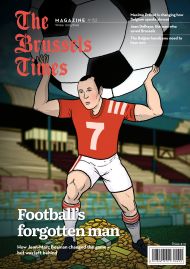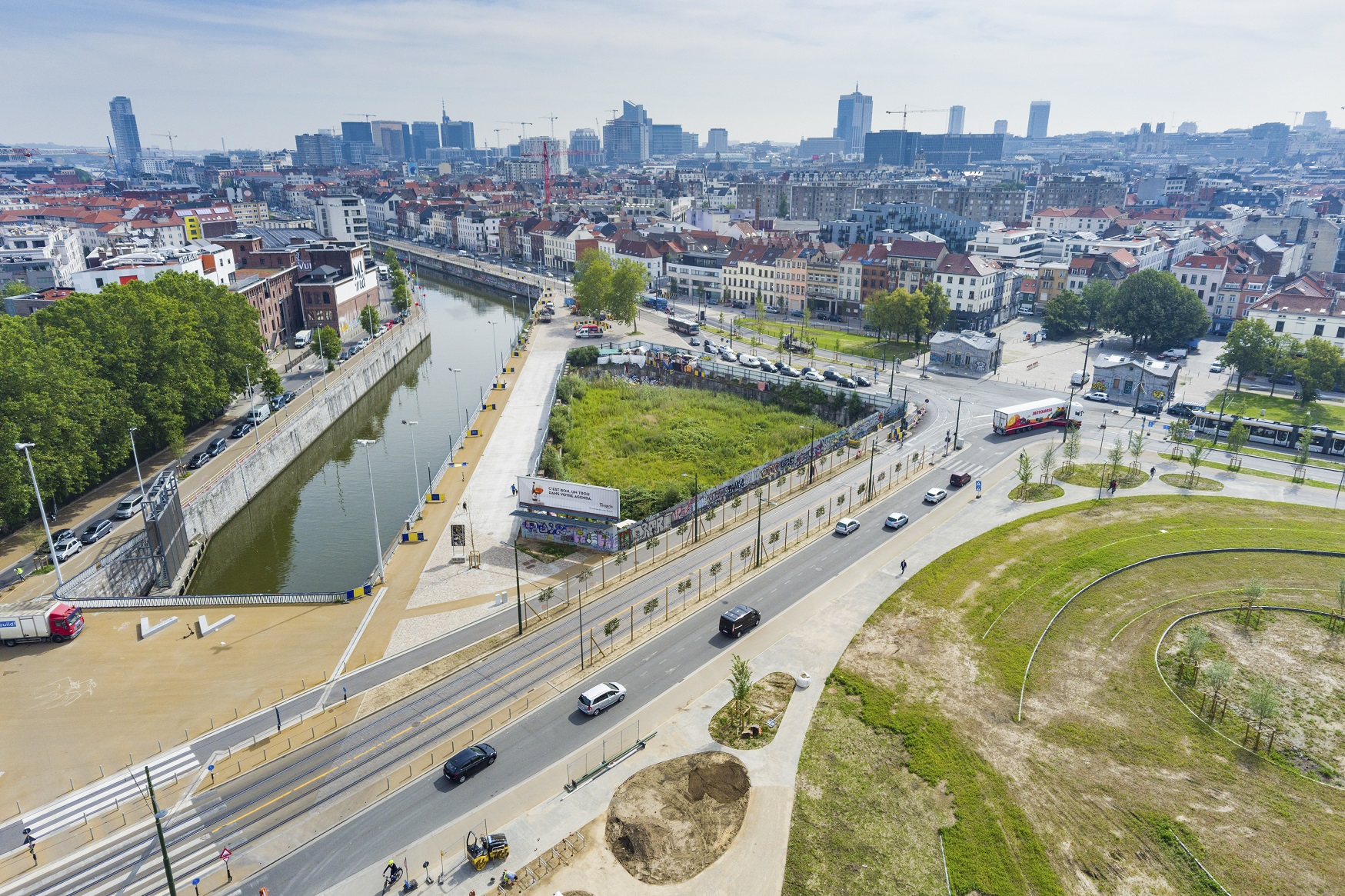The Brussels Canal neighbourhood used to be avoided. Once the industrial hub of the country, it fell into decline in the post-war era. For decades, the entire zone along the waterway was a run-down area known for its derelict buildings, its neglected housing and its crime. Now, however, it is enjoying a revival as manufacturing returns, new homes are built and cultural attractions thrive.
It has taken a long time. Deindustrialisation meant brownfield sites emerged and building stock deteriorated, creating blighted neighbourhoods. When the Brussels Region was created in 1989, it began designing initiatives to revitalise the area. working with the three communes through which the canal flows, Brussels city, Molenbeek and Anderlecht.
These projects did garner some successes such as the repopulation of the right bank of the canal from the water to the central city boulevards. But a more concerted effort was needed.
The Brussels regional authorities launched the Canal Plan (CP) in 2015, with its 10-year strategy to keep economic activity in the city, bring people’s workplaces and homes closer together, while developing housing, industrial parks and facilities for leisure and cultural activities.
There are close to 100 CP projects either completed, in progress or projected within the canal zone with public, private and mixed enterprises building them. It is impossible to travel through the area and not see renewal, large and small.
The variety of actors is essential to the plan: the CP proposes the co-construction of projects between public and private actors to ensure adherence to the principles set out by the public authorities and the feasibility of projects. Each project owner receives support and guidance, from the definition of the project through to its implementation.
Karine Lalieux, the federal minister for pensions and social integration says the CP is concentrating on green space creation and soft mobility. “This both for their inherent attributes for enhancing city life but also as ways of breaking the physical barriers between neighbourhoods such as the canal, by fostering physical links that break the psychological barriers as well,” she says.
Beliris, set up by the federal government and the Brussels region to finance and oversee the new projects, is spending some €100m in the canal zone.
Completed projects in the canal zone include the redevelopment of the west inner ring from the Porte de Ninove to Place Sainctelette which created bicycle and pedestrian paths along the canal (€15.4m), two bike and pedestrian bridges over the canal (€2.9m), and the complete redevelopment of the Porte de Ninove, separating through traffic, local traffic and soft mobility and the creation of a new park (€28.5m).
Another crossing is the soon-to-be-completed Suzan Daniel Bridge, which will link the North Quarter with Tour & Taxis site and will carry pedestrians, cyclists, trams and buses (€6.7m). All three bridges are fundamental to the goal of reconnecting these areas, which, though next to each other, are isolated from one other.
Hotly anticipated is the 28,000 square metre linear park that will occupy the west bank of the canal from Place Sainctelette to the Place des Armateurs bridge (€14.8m).
Projects still in the planning phase include the conversion of two warehouses in Molenbeek into a circus school and a recycling centre (€4.7m), the conversion of a printing house in Anderlecht into a socio-cultural centre (€4m), and the creation of public and green spaces in the new Biesterbroeck neighbourhood along the canal in Anderlecht (€8.6m).
Beer project
Key to the CP is attracting business. One of those is the Brussels Beer Project (BBP). Brussels went from well over 100 breweries at the beginning of the 20th century to just one a decade ago, but BBP is part of the beer renaissance in the city. When their brewery on Rue Dansaert became too small for their expanding business, they began searching for a new location.
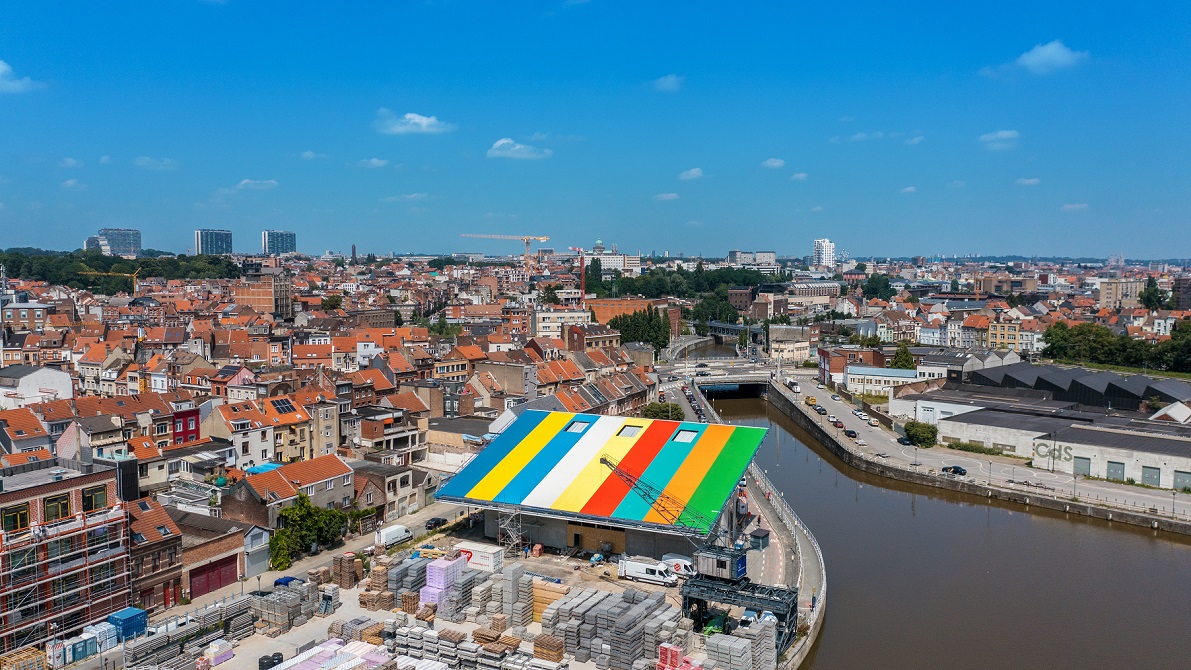
© BPP
BBP co-founder Sébastien Morvan says he was attracted by the prospect of starting on a fresh site. "I remember a meeting with the commune of Anderlecht, four or five years ago. They said, 'You can go to Tours &Taxi, there’s still room there, or you can come here at Port Sud where everything is yet to be built,’” he said. “And we thought, ‘Well, here we can really make a difference, create what we need and want.’ A year and half ago this location was an unauthorised rubbish dump. There was motor oil, frying oil, tyres, and all sorts of rubbish, there were drug sales going on, it was not a safe area.”
The BBP’s ethos fits in with the CP. It is based on three key elements: collaboration with the community; experimenting with new brewing concepts; and supporting the circular economy. “We are in symbiosis with the neighbourhood, the commune and the region,” says Morvan. “The project was done in collaboration. That’s the way we work, we don’t work isolated. Before our bottling capacity was 2,000 per day, now it's 30,000 and that will grow.”
The Brussels and Anderlecht authorities hope the BBP can lead the way for others. For decades urban industry drifted away, but now the narrative is of a productive city that welcomes people, “They brought us resources,” says Morvan. “It’s thanks to them that we were able to organise an architecture competition for our new brewery, pulling together amazing architects – we had no such connections.”
Green housing
Many of the old industrial sites are being replaced not by new businesses, but rather with housing. The most striking housing spree is on the east bank, between Armateurs and Sainctelette, which includes UP-site, Belgium’s tallest residential tower.
Further north, beyond Tours & Taxis, is Tivoli GreenCity, a pioneering project that is home to around 400 passive and zero-energy housing units, an SME park, a fablab, an incubator for sustainable entrepreneurship, retail businesses, two nurseries and many common meeting spaces.
The district is equipped with a dozen collective vegetable gardens on the roofs, an experimental greenhouse, a wooded square and gardens inside the blocks, as well as 663 parking spaces for bicycles and 45 nesting boxes for swifts, sparrows and bats. The artisan workshops in the SME park create a higher concentration of jobs than regular commercial workshops.
“We want to recreate a mixed industry/housing urban fabric where we eliminate the nuisances but also where the mixing of the two becomes a plus,” says Tivoli GreenCity CEO Benjamin Cadranel. “The aim of the game is to reach a social mix, so there is neither a high end or a low-end ghetto.”
Centred around three striking century-old trees and replacing an old industrial neighbourhood, Tivoli has won eight BREEAM Awards, recognising sustainable infrastructure and building projects around the world.
Nurturing culture
A final way in which the CP is changing the zone is the emerging cultural offer. Until recently, the major museums in Brussels were all either on the Mont des Arts or in Cinquantenaire Park. Now, bordering, the canal from the Porte de Ninove to the Place Sainctelette are three important institutions.
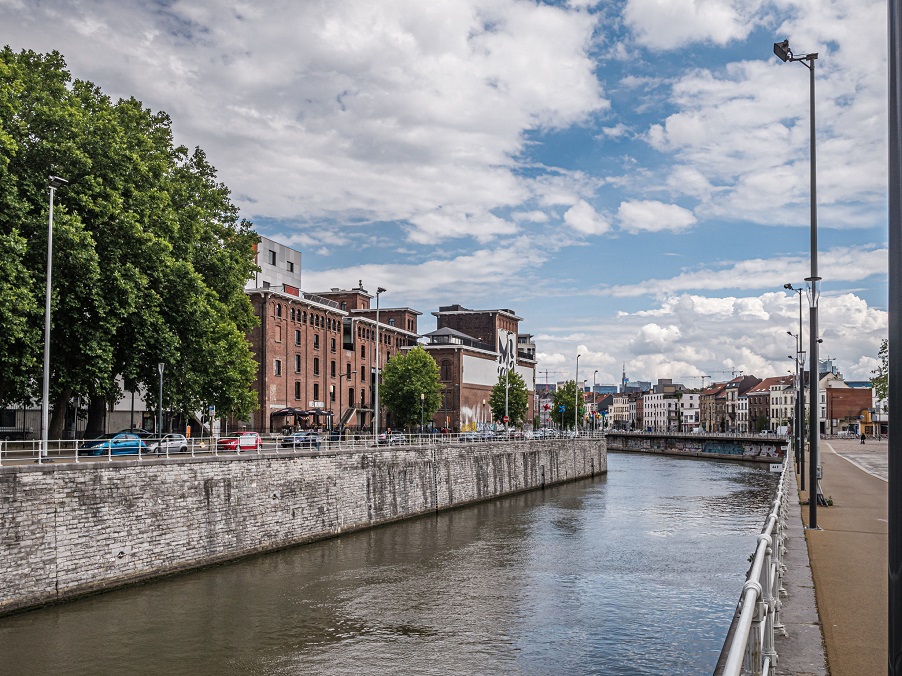
The Millennium Iconoclast Museum of Art (MIMA)
The first is the Millennium Iconoclast Museum of Art (MIMA) housed in an old brewery, which presents exhibitions "that highlight a young generation that transgresses the artistic genres, a grassroots people's art movements that creates new museum-going visitors." The second is iMAL, the Brussels' centre for new media and digital arts that aims to support and showcase artistic and creative practices based on digital media. And the third is KANAL-Centre Pompidou, set to be one of the largest contemporary art museums in the world, housed in the former Citroën plant.
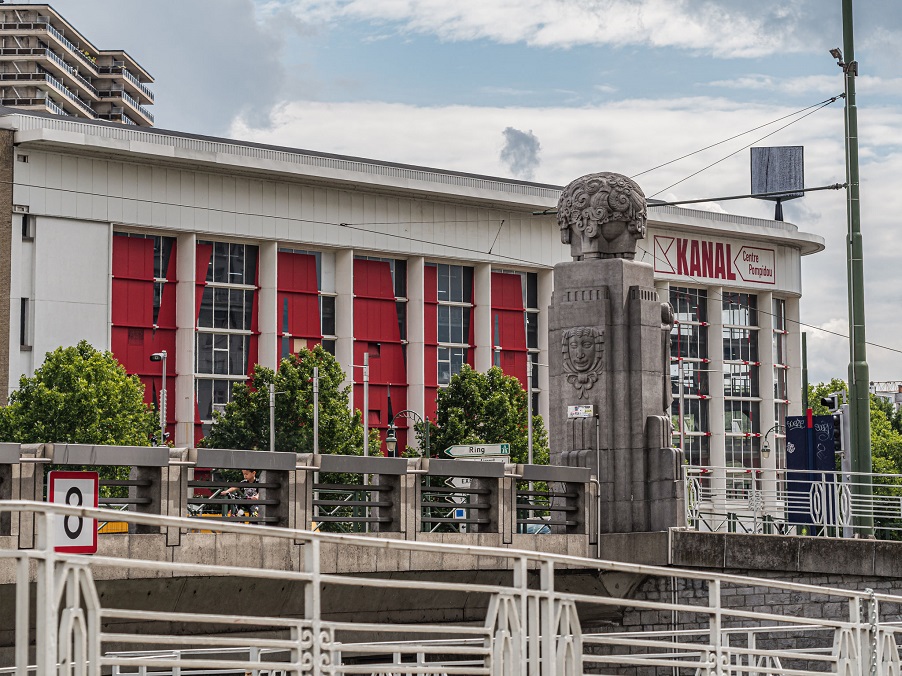
KANAL - Centre Pompidou © visit.brussels
These new institutions reinforce the CP’s goals of unifying the disparate communities of the city. Supporting them in this effort are a few other cultural venues. They include Recyclart, a non-profit organisation that manages a multi-disciplinary arts centre, a bar/restaurant and a wood/metal working space, hosting parties, concerts, exhibitions, community-based initiatives and lectures on architecture, public space and design.
Others are La Fonderie, a museum/research centre dedicated to preserving Brussels' industrial history with exhibitions and hands-on workshops and De Vaartkapoen, an experimental community centre and a music club that provides a stage for young artists and local groups on which to perform for the public.
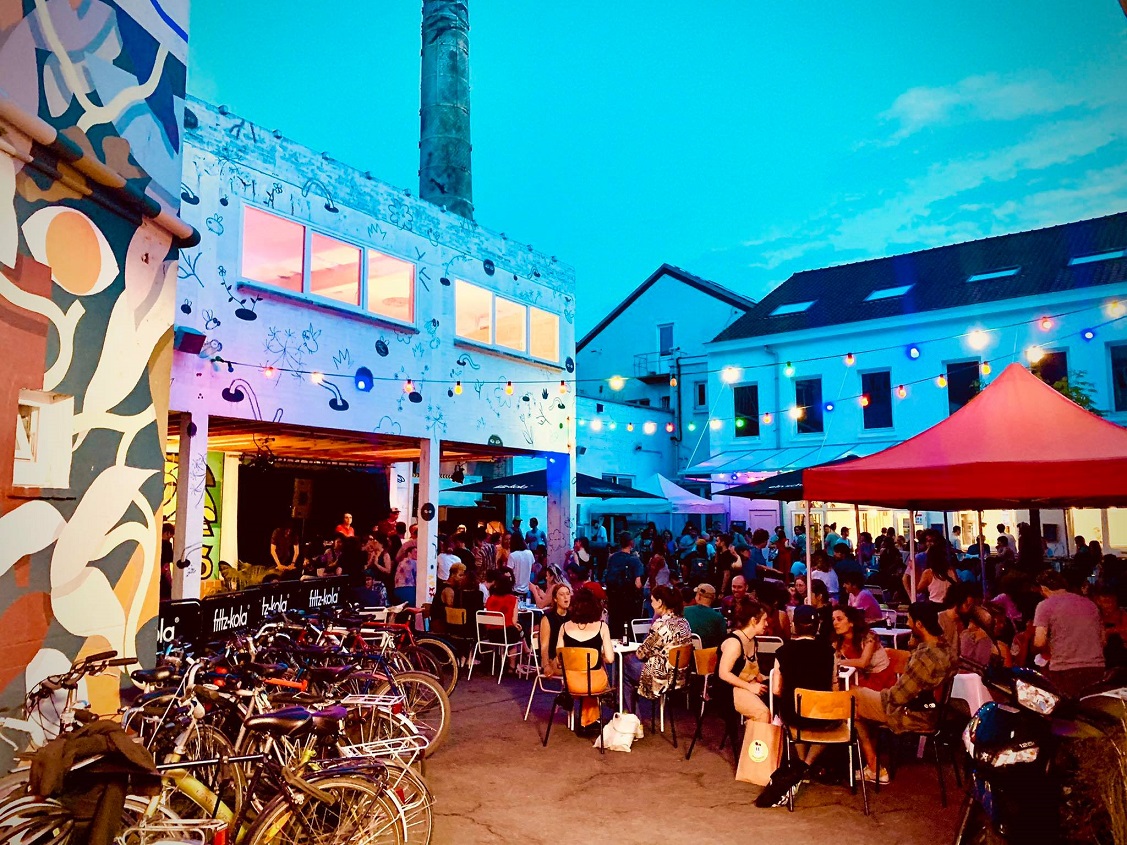
© La Vallée
La Vallée is perhaps the most intriguing of the lot, a non-profit that provides third place workspaces and also produces events. Located in a 6,000 square metre former laundry in Molenbeek, half the building is devoted to workshops for a wide variety of creative entrepreneurs: artists, ceramists, painters and photographers. It also houses filmmakers, writers, social associations like Le Pont des Arts (art into hospitals for sick children,) and a recording studio available to local youth, for a total of 200 tenants
“We realized that many creative people couldn’t afford to rent both a place to live and a place to work so we decided to offer workspaces for less than the going rate,” says La Vallée manager Pierre Pevée. “They pay very low rents and their leases are open-ended.”
In the eight years since La Vallée was set up, Pevée has seen a lot of changes in the neighbourhood: it is more diverse and people are becoming more familiar with each other after an initial set of culture clashes over noise and drinking. “It’s important to gain people’s trust,” Pevée says. “One thing we did was make the neighbourhood youth responsible for the security by paying for the training of ten local youths in security. They now take care of security at all our events.”
Pevée pauses before making a point that could apply to the entire canal revival project. “It has been successful: we forged links between different groups and we created jobs which formed a strong feeling of belonging,” he says.
A canal run
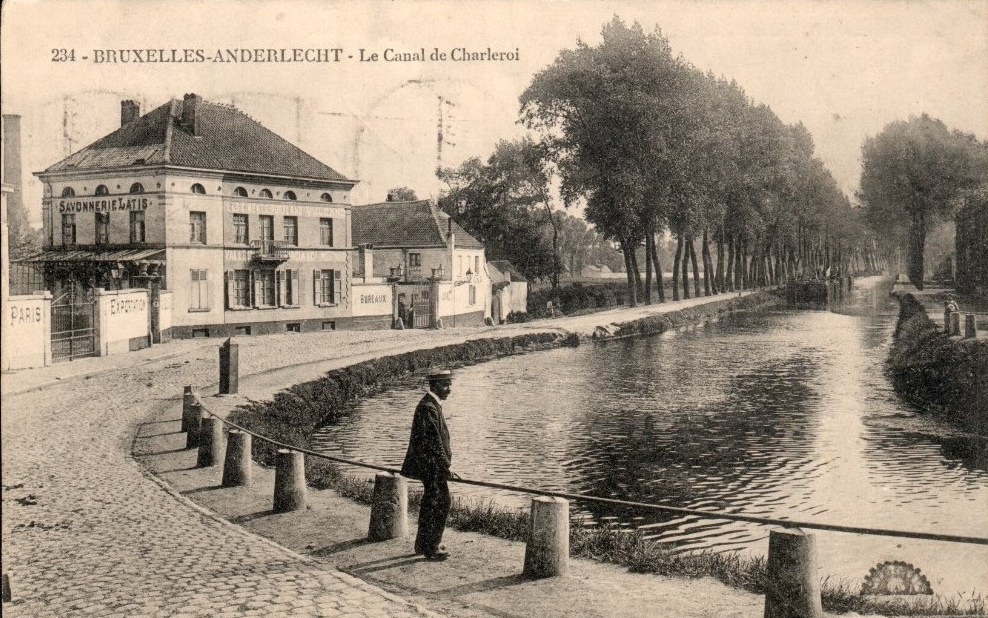
The Anderlecht section of the Brussels-Charleroi canal in the 1920s
The canal that runs through Brussels is actually two waterways built three centuries apart, the Willebroeck Canal (also known as Brussels–Scheldt Maritime Canal) that goes to the north and the Brussels-Charleroi Canal that goes to the south.
Brussels developed where it did because it was the farthest point upstream that the Senne river was navigable. The major transportation routes from the south converged, and goods were loaded onto river boats for the trip to the port of Antwerp and then beyond, via seagoing vessels.
The first port of Brussels attracted merchants and artisans. It grew in importance with a network of water mills which not only supported industry but also created fishponds and irrigation until it attracted the dukes of Leuven who adopted it as their capital.
The Senne may have been navigable but it meandered to such an extent that the journey from Brussels to Antwerp – just 45km as the crow flies – took 120km to complete down the river, a week-long voyage at the time. Additionally, the city of Mechelen, which, unlike Brussels and Antwerp, was not part of the Duchy of Brabant, levied tolls on all passing ships.
Despite their rivalry, Antwerp and Brussels worked together to build a canal to bypass Mechelen and slash the trip to a one-to-two-day voyage.
The result was the technologically audacious Willebroeck Canal, one of the three oldest canals in Europe. Mary, Duchess of Burgundy authorised it at the start of her reign in 1477, but the ensuing civil war caused by her marriage to Maximilian of Habsburg halted the project. It was not until 1551 that Mary’s grandson, Emperor Charles V, launched the scheme and the canal was completed in ten years.
The 18th century saw the development of new industries including printing, coach building and pottery, some of them in the city centre but many along the Senne river valley in Anderlecht and Molenbeek. The industrial and urban boom led to acute demands for coal and other raw materials from the mines in Charleroi. Hence the canal in the south: the digging began in 1827, and it was inaugurated in 1832.
The two canals met at what is now the Place de l’Yser. By facilitating the arrival of massive amounts of coal, the new canal helped usher in Belgium’s industrial revolution: new heavier industries proliferated, including foundries that produced, among other things, locomotives; machine shops and metal shops.
In turn this allows for the rapid expansion of the railway network and by end of the 19th century, Belgium became, per capita, the third industrial power in the world. The area along the canal in Brussels was one of the most concentrated industrial zones worldwide.
By the start of the 20th century, all this industrial activity had saturated the railway network and the decision was taken to make Brussels a seaport. Three massive deeper and wider harbour basins were inaugurated in 1922 so that the river barge traffic could be joined by seagoing vessels. To make a straighter connection, the Willebroeck Canal was realigned: the junction between the two canals was moved 80 metres to the west to its current position at Place Sainctelette.
The extensive Tour & Taxis industrial complex was developed in 1902, including a freight station, custom halls and warehouses. New industries appeared: petrochemical works, gas works, cement works, and coke ovens.
However, after the Second World War, coal and steel production in Wallonia crumbled, while the centre of economic gravity shifted to Flanders – and the service economy. The canal’s role as an economic hub declined, leaving in its wake a swathe of derelict former sites. The middle classes moved out, replaced along the canal by poor, immigrant populations. Over a 40-year period, industrial jobs in Brussels fell from 160,000 to 30,000.
Today, some 6.5 million tonnes of goods now pass through the Port of Brussels every year, and the canal area has been home to some 6,000 companies across all sectors. Analysts say that from an air pollution perspective, the canal traffic has removed the equivalent of over 611,000 truckloads of carbon emissions.
